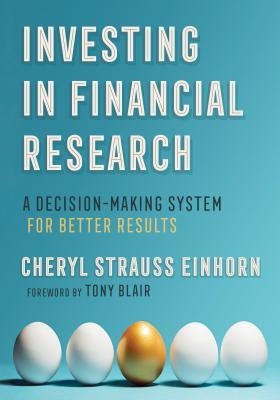
Chapter One
The Origins of the AREA Method
There’s an alternative. There’s always a third way, and it’s not a
combination of the other two ways. It’s a different way .
—David Carradine
Every day, people around the world make fi nancial decisions. They
choose to invest in a stock, sell their holdings in a mutual fund, or buy a
condominium. These decisions are complex and fi nancially tricky—even
for fi nancial professionals. But the literature available on fi nancial research
is dated and either focuses narrowly on only one aspect of fi nancial sleuth-
ing, such as earnings quality, or provides a bird’s-eye view without any
real practical application. Until now there’s been a gap in the literature: a
book that shows you how to conduct a step-by-step comprehensive fi nan-
cial investigation that ends in a decision.
This book gives you that how .
Investing in Financial Research: A Decision-Making System for Better
Results is a guidebook for conducting fi nancial investigations. The book
lays out my AREA Method—a research and decision-making system
that uniquely controls for bias, focuses on the incentives of others, and
expands knowledge while improving judgment—and applies it to inves-
tigating fi nancial situations. AREA is applicable to all sorts of fi nancial
sleuthing, whether for investment analysis or investigative journalism.
I fi rst laid out my AREA Method in a general interest book about how
to make complex personal and professional decisions. That book is titled
Problem Solved: A Powerful System for Making Complex Decisions With
Confi dence and Conviction. For my Problem Solved readers the basic
AREA roadmap is largely the same. However, this book uses fi nancial
case studies, drills down deeper into company fi nancials, has an in-depth
discussion of fraud and deception, and includes many more fi nancially
focused Cheetah Sheets.
If you are new to the AREA Method: Welcome aboard! The AREA
Method helps you make smarter, better decisions by improving upon clas-
sic research and decision-making pedagogy.
How does it do that? First, AREA recognizes that research is a funda-
mental part of decision-making. Second, AREA organizes your research
process based on the perspective of the source of your information. Third,
it addresses the critical component of timing head-on, incorporating cal-
culated and directed refl ections that promote insight, slowing down to
speed up the effi cacy of your work. And fourth, AREA provides a clear,
concise, and repeatable process that works as a feedback loop in part or
in its entirety. Result: AREA is the fi rst decision-making system to control
for bias, focus on the incentives of others, and expand knowledge while
improving judgment
My research process is called the AREA Method because of the differ-
ent perspectives it addresses. AREA is an acronym for these perspectives:
Absolute, Relative, Exploration and Exploitation, and Analysis.
The fi rst “A,” or “Absolute,” refers to primary, uninfl uenced informa-
tion from the source or sources at the center of your fi nancial research.
“R,” or “Relative,” refers to the perspectives of outsiders around your
research subject. It is secondary information, or information that has
been fi ltered through sources connected to your subject. “E,” or “Explo-
ration” and “Exploitation,” represents the twin engines of creativity, one
being about expanding your research breadth and the other about depth.
Exploration moves your research beyond written documents to teach you
to listen to other peoples’ perspectives by developing sources and interview-
ing. Exploitation asks you to focus inward, on you as the decision-maker,
to examine how you process information, exploring and challenging your
own assumptions and judgment. The second “A,” “Analysis,” synthe-
sizes all of these perspectives, processing and interpreting the information
you’ve collected. Each of these steps will be explained in detail in the
chapters that follow.
Together the “A” and the “R” provide you with the tools necessary
to create a framework for gathering and evaluating information. The
latter part of the AREA process, the “E” and the “A,” provide detailed




